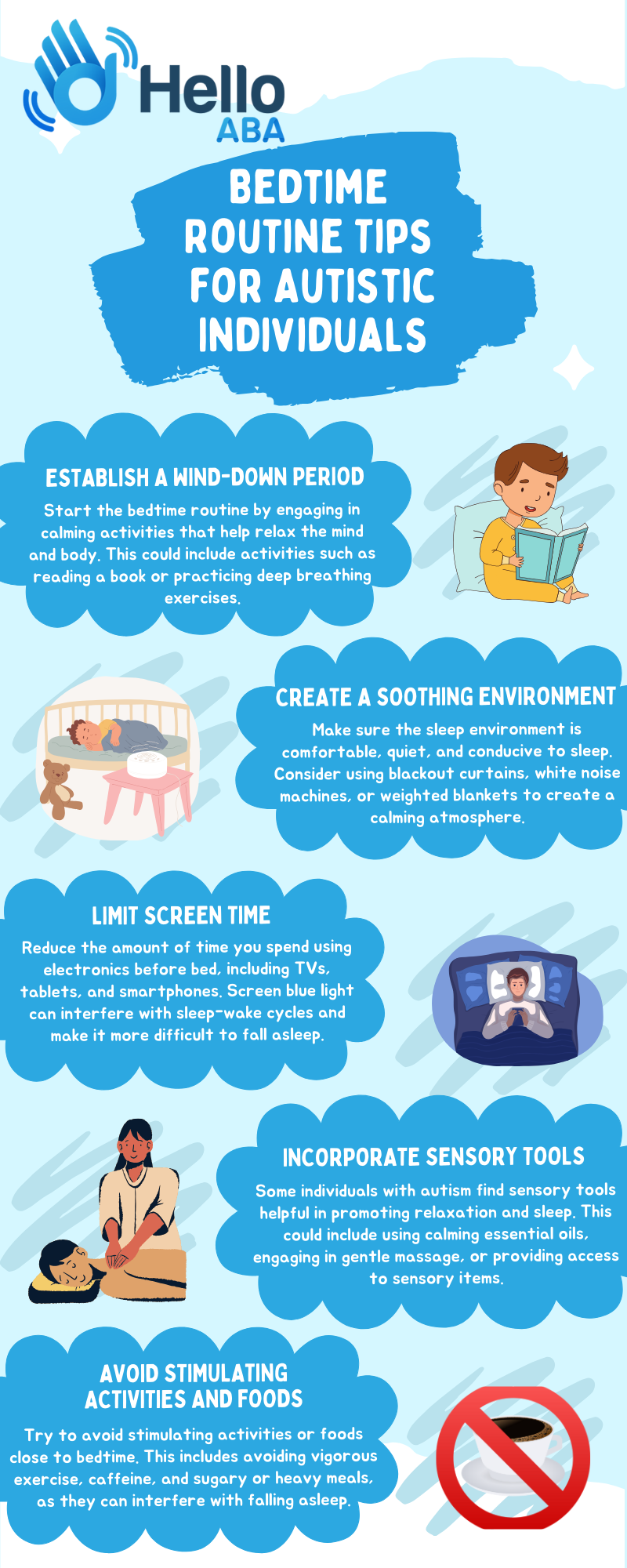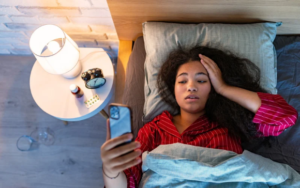Sleep is a fundamental aspect of overall health and well-being, and it’s particularly crucial for individuals with autism spectrum disorder (ASD). Many people with autism experience sleep disturbances. Establishing a consistent sleep schedule and a calming bedtime routine can significantly improve sleep quality and overall functioning.

Prevalence of Sleep Issues
A 2019 study estimated that between 44 and 83% of kids on the autistic spectrum have trouble sleeping. When compared to children who are neurotypical, this prevalence is noticeably higher. Caretakers most frequently report sleep difficulties, such as trouble falling asleep and early morning wakefulness.
Sleep Challenges | Prevalence in Children with Autism |
Difficulty falling asleep | 44-83% |
Frequent night wakings | 44-83% |
Early morning waking | 44-83% |
Impact of Sleep Difficulties
The impact of sleep difficulties on individuals with autism and their families can be far-reaching. Sleep disturbances can lead to daytime sleepiness, irritability, difficulty concentrating, and impaired cognitive functioning. These effects can impact various aspects of daily life, including academic performance and social interactions.
Effects of Sleep Difficulties in Autism |
Daytime sleepiness |
Irritability |
Difficulty concentrating |
Impaired cognitive functioning |

Melatonin as a Sleep Aid
For individuals with autism who struggle with sleep difficulties, melatonin has emerged as a potential solution to improve sleep quality. It is a hormone naturally produced by the body that helps regulate the sleep-wake cycle. Let’s explore the effectiveness of melatonin as a sleep aid and the benefits of a new melatonin mini-pill.
Effectiveness of Melatonin
Research has shown that children with ASD can experience improvements in their sleep when given melatonin in combination with oral instructions for parents on strategies to promote sleep. Melatonin supplementation has been found to decrease the time it takes to fall asleep and increase total sleep time in individuals with autism.
Benefits of Melatonin Mini-Pills
A melatonin mini-pill was launched in Europe in October 2018 and in the U.S. thereafter. This innovative pill is designed to be easy for kids to swallow and is formulated as a slow-release medication. It has been shown to be effective in decreasing the time spent falling asleep and increasing the overall duration of sleep.
To ensure the proper use of melatonin as a sleep aid, it is essential to consult with a professional who can provide appropriate guidance. It is important to note that melatonin should be used as part of a comprehensive approach to addressing sleep difficulties, which may include addressing any underlying medical issues.
Parenting Strategies for Better Sleep
Parents and caregivers play a vital role in helping individuals with autism establish a healthy sleep routine. By implementing effective parenting strategies, it is possible to promote better rest. Here, we will discuss two key strategies: addressing the co-sleeping dilemma and implementing strategies for teenagers.
Co-Sleeping Dilemma
Many parents of children with autism find themselves caught in the co-sleeping dilemma. While lying down with your child can provide an opportunity for connection, it can also reinforce their perceived need for your presence in order to sleep. This can lead to dependency and difficulties when your child wakes up during the night.
To address this dilemma, it is important to gradually transition your child to independent sleeping. Start by gradually reducing the amount of time you spend lying down with them each night. This can be done by slowly moving away from their bed. Implementing a bedtime routine chart can also help in setting clear expectations.
Strategies for Teenagers
One common change during adolescence is a shift in sleep rhythms. Teenagers tend to become sleepy later, which can conflict with school schedules. If there is flexibility in your teen’s schedule, gradually shifting their bedtime by pushing it back 30 minutes every few days can be helpful.
Additionally, it’s critical for teenagers to develop a regular sleep schedule. Before going to bed, encourage them to do something calming, like read or listen to music. Reducing the amount of time spent using electronics, especially in the hour before bed, can also help you sleep better.

Sleep Routine Importance
Establishing a consistent sleep routine is crucial for individuals with autism. A well-structured sleep routine can help regulate sleep patterns, improve overall sleep quality, and promote better daytime functioning. In this section, we will explore the importance of a consistent sleep schedule and provide some bedtime routine tips.
Consistent Sleep Schedule
Keeping a regular sleep schedule is essential for people with autism. A regular sleep schedule can have a big impact on the quality of your sleep. The body’s internal clock, which tells the body when it’s appropriate to sleep and when to wake up, is regulated when bedtime and waking time are kept regular.
Creating a visual schedule can be helpful in establishing a sleep routine. Visual schedules provide a predictable outline of the bedtime routine, allowing individuals with autism to understand the steps involved. This visual support can reduce anxiety and provide a sense of structure and security.
Bedtime Routine Tips for Autistic Individuals
A bedtime routine is a series of activities that prepare the mind and body for sleep. For individuals with autism, a well-designed bedtime routine can be particularly beneficial in promoting a smooth transition to sleep. Here are some tips to consider when developing a bedtime routine:

Managing Anxiety for Better Sleep
Anxiety can significantly impact the quality and duration of sleep for individuals with autism. However, there are strategies that can help manage anxiety and promote better sleep. Effective communication and clear explanations can play a crucial role in alleviating anxiety related to sleep.
Anxiety Impact on Sleep
Anxiety can lead to a range of sleeping difficulties in individuals with autism. The anticipation of stressful events or worrying thoughts can make it challenging to fall asleep and maintain a restful sleep throughout the night. Anxiety-related sleep issues may include:
- Difficulty falling asleep
- Frequent awakenings during the night
- Restlessness or tossing and turning in bed
- Nightmares or vivid dreams
- Insomnia or prolonged periods of wakefulness
Communication Strategies
Clear and open communication plays a vital role in managing anxiety related to sleep. Here are some strategies that can be helpful:
- Create a Safe Environment: Establish an open and supportive environment where individuals with autism feel comfortable expressing their feelings and concerns about sleep. Encourage them to share any fears or worries they may have related to bedtime or sleep.
- Visual Supports: Utilize visual supports such as social stories, visual schedules, or visual cues to help individuals with autism understand the sleep routine and what to expect. Visual supports can provide a sense of predictability and alleviate anxiety.
- Bedtime Rituals: Establish a calming bedtime routine that incorporates activities individuals with autism find relaxing and enjoyable. This can include activities such as reading a book, listening to calming music, or engaging in sensory activities like deep pressure or gentle massage.
- Relaxation Techniques: Teach and practice relaxation techniques with individuals with autism to help them manage anxiety before bedtime. Deep breathing exercises, progressive muscle relaxation, or guided imagery can assist in promoting a sense of calmness and reducing anxiety.
- Active Listening: Actively listen to the concerns and fears expressed by individuals with autism regarding sleep. Provide reassurance and validate their emotions, letting them know that their feelings are acknowledged and understood.
It is important to note that while these strategies can be beneficial, it is always recommended to consult with healthcare professionals or specialists who can provide personalized guidance and support for managing anxiety and improving sleep in individuals with autism.
Creating a Sleep-Friendly Environment
Maximizing the benefits of a sleep schedule also involves creating a sleep-friendly environment plays a crucial role. By implementing strategies that promote a calm and relaxing atmosphere, individuals with autism can experience improved sleep quality. Two key factors to consider are screen time reduction and the use of sensory tools.

Screen Time Reduction
Cutting back on screen time, especially in the evening, can have a significant impact on sleep for individuals with autism. Watching TV, videos, or playing on the computer, particularly if the content is scary or violent, can heighten arousal levels and make it more challenging to fall asleep. By limiting screen time before bedtime, individuals can better prepare their minds and bodies for restful sleep.
Sensory Tools for Better Sleep
Incorporating sensory tools into the sleep environment can help create a soothing and calming atmosphere. These tools can vary depending on individual preferences but may include items such as soothing music, relaxing fragrances, weighted blankets, or soft textures. Experimenting with different sensory tools can help identify what works best for each individual and promote a more restful sleep.
Recommendation | Details |
Use soothing music or white noise | Playing calming music or using white noise machines can help drown out external sounds and create a peaceful environment for sleep. |
Experiment with relaxing fragrances | Certain scents, such as lavender or chamomile, are known for their calming effects. Trying different fragrances through essential oils or diffusers may aid in promoting relaxation before sleep. |
Consider weighted blankets | The gentle pressure provided by weighted blankets can have a calming effect and promote a sense of security, aiding in sleep for some individuals with autism. |
Opt for soft and comforting textures | Incorporating soft and comforting textures, such as cozy blankets or plush pillows, can enhance the sensory experience and contribute to a more relaxing sleep environment. |
By reducing screen time before bedtime and utilizing sensory tools, individuals with autism can create a sleep-friendly environment that promotes better sleep quality. With a soothing and calming sleep environment, individuals with autism can enhance their overall sleep routine and experience the benefits of improved sleep.
If you’re looking for expert guidance and support in creating a personalized sleep plan for your child with autism, Hello ABA offers comprehensive autism services in Maryland. Our highly trained ABA therapists work closely with families to develop effective strategies for addressing sleep challenges and improving overall well-being.
Contact us today to learn more about how we can help your child sleep better and thrive!






